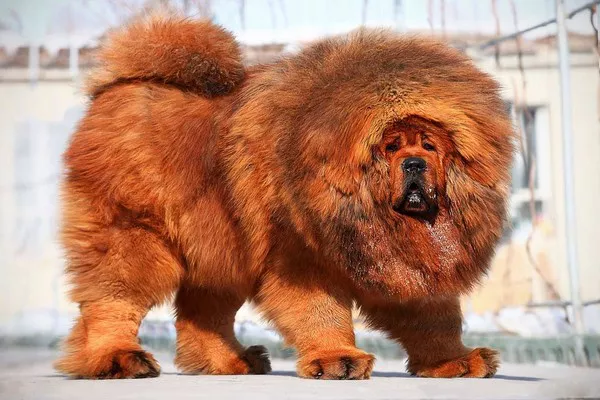Tibetan Mastiffs are an ancient and powerful breed of dog that were originally bred in Tibet as guardians of livestock and property. Today, Tibetan Mastiffs are known for their protective instincts and loyalty to their families. As with any breed of dog, there is a breed standard that outlines the ideal characteristics and physical traits of the Tibetan Mastiff. In this article, we will explore the breed standard for the Tibetan Mastiff, including its history, appearance, and temperament.
History of the Tibetan Mastiff:
The Tibetan Mastiff is an ancient breed of dog that has been around for thousands of years. They were originally bred in Tibet as guardians of livestock and property, and were highly valued for their strength and protective instincts.
Tibetan Mastiffs were also used as guard dogs by Tibetan monks, who believed that they had spiritual and mystical powers. The dogs were often kept in monasteries and were considered to be sacred animals.
In the mid-19th century, Tibetan Mastiffs were introduced to Europe and other parts of the world, where they became popular as show dogs and pets. Today, the Tibetan Mastiff is recognized as a distinct breed by the American Kennel Club and other major kennel clubs around the world.
Appearance:
The Tibetan Mastiff is a large and powerful dog, with a thick, heavy coat and a muscular build. They have a broad head and a strong, square jaw, with small, deep-set eyes and floppy ears.
The coat of the Tibetan Mastiff is thick and woolly, and can be any color, including black, brown, red, and gold. The coat requires regular grooming to prevent matting and tangling, and may shed heavily during certain times of the year.
According to the breed standard, male Tibetan Mastiffs should stand between 26 and 30 inches tall at the shoulder, and weigh between 100 and 160 pounds. Females should stand between 24 and 28 inches tall, and weigh between 70 and 120 pounds.
The breed standard also outlines specific physical characteristics for the Tibetan Mastiff. The head of the Tibetan Mastiff should be large and heavy, with a broad skull and a deep, square muzzle. The eyes should be small and deep-set, and the ears should be V-shaped and hang down close to the head.
The neck of the Tibetan Mastiff should be strong and muscular, with a deep chest and a broad, powerful body. The legs should be strong and straight, with large, round feet. The tail should be long and feathered, and should hang down to the hocks.
Temperament:
The Tibetan Mastiff is known for its protective instincts and loyalty to its family. They are independent and intelligent dogs, but can also be stubborn and willful.
Because of their protective nature, Tibetan Mastiffs may be wary of strangers and may require socialization and training to be comfortable around new people and animals. They are also known to be aloof and independent, and may not be as eager to please their owners as some other breeds.
However, with proper training and socialization, Tibetan Mastiffs can make excellent family pets. They are loyal and affectionate with their families, and are known for their bravery and courage.
Breed Standard:
The breed standard for the Tibetan Mastiff outlines the ideal characteristics and physical traits of the breed. According to the American Kennel Club, the breed standard for the Tibetan Mastiff includes the following:
General Appearance: The Tibetan Mastiff should be a large, powerful dog with a thick, heavy coat. They should have a broad head and a strong, square jaw, with small, deep-set eyes and floppy ears.
Size: Male Tibetan Mastiffs should stand between 26 and 30 inches tall at the shoulder, and weigh between 100 and 160 pounds. Females should stand between 24 and 28 inches tall, and weigh between 70 and 120 pounds.
Coat: The coat of the Tibetan Mastiff should be thick and woolly, and can be any color, including black, brown, red, and gold.
Temperament: The Tibetan Mastiff should be protective and loyal to its family, but may be wary of strangers. They should be independent and intelligent, but may also be stubborn and willful.
Movement: The Tibetan Mastiff should have a powerful and fluid gait, with a long, smooth stride.
Head: The head of the Tibetan Mastiff should be broad and strong, with a square jaw and small, deep-set eyes.
Neck and Body: The neck of the Tibetan Mastiff should be strong and muscular, with a deep chest and a broad, powerful body.
Tail: The tail of the Tibetan Mastiff should be long and feathered, and should hang down to the hocks.
Feet: The feet of the Tibetan Mastiff should be large and round, with well-arched toes and thick pads.
Coat and Color: The coat of the Tibetan Mastiff should be thick and woolly, and can be any color, including black, brown, red, and gold.
Gait: The Tibetan Mastiff should have a powerful and fluid gait, with a long, smooth stride.
Temperament: The Tibetan Mastiff should be protective and loyal to its family, but may be wary of strangers. They should be independent and intelligent, but may also be stubborn and willful.
Conclusion:
The breed standard for the Tibetan Mastiff outlines the ideal characteristics and physical traits of this ancient and powerful breed. The Tibetan Mastiff is known for its protective instincts and loyalty to its family, and requires proper training and socialization to be comfortable around new people and animals. With its thick, woolly coat and muscular build, the Tibetan Mastiff is a striking and impressive breed that has captured the hearts of dog lovers around the world. By understanding the breed standard, breeders and owners can ensure that their Tibetan Mastiffs are healthy, happy, and true to their ancient heritage.


